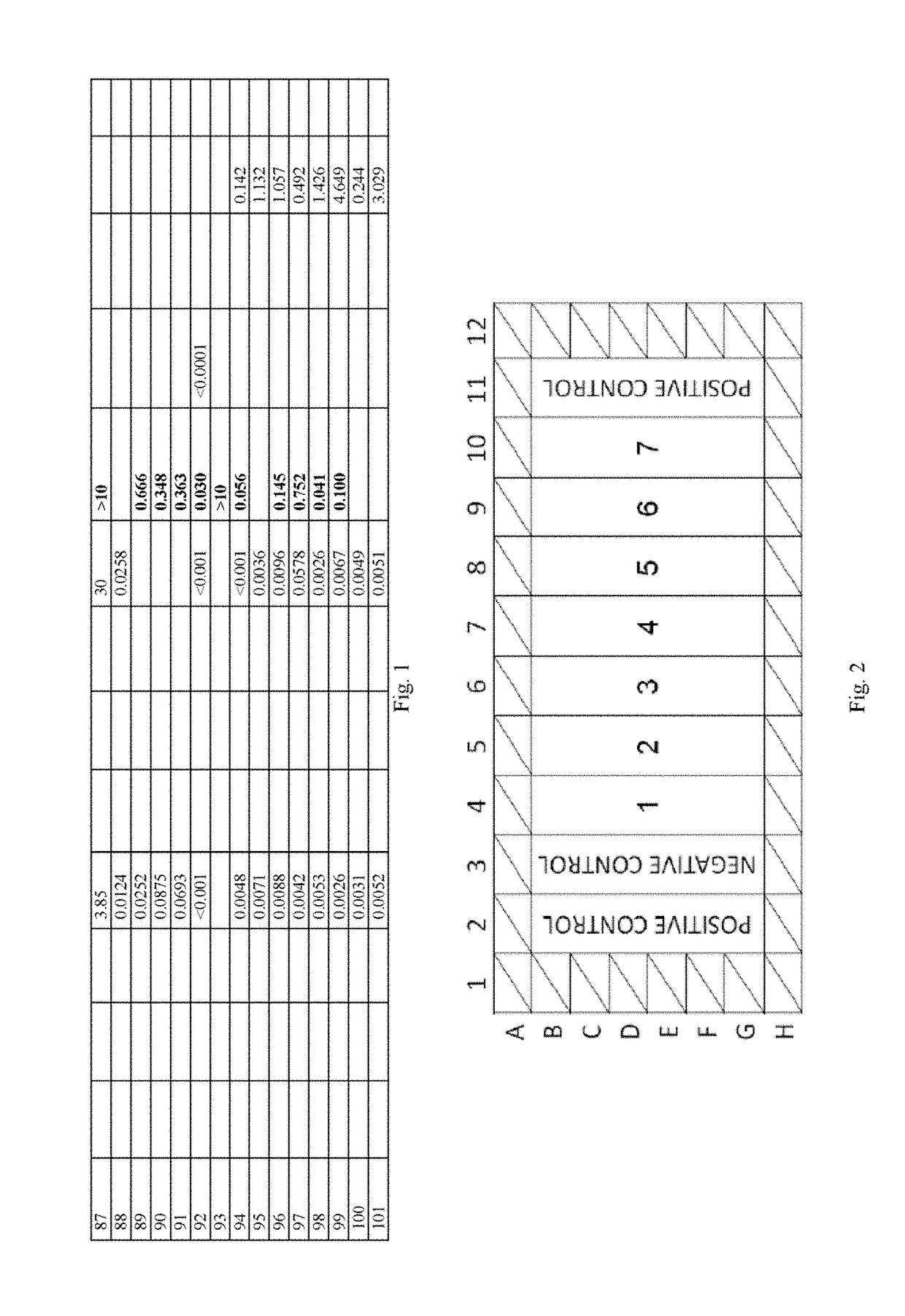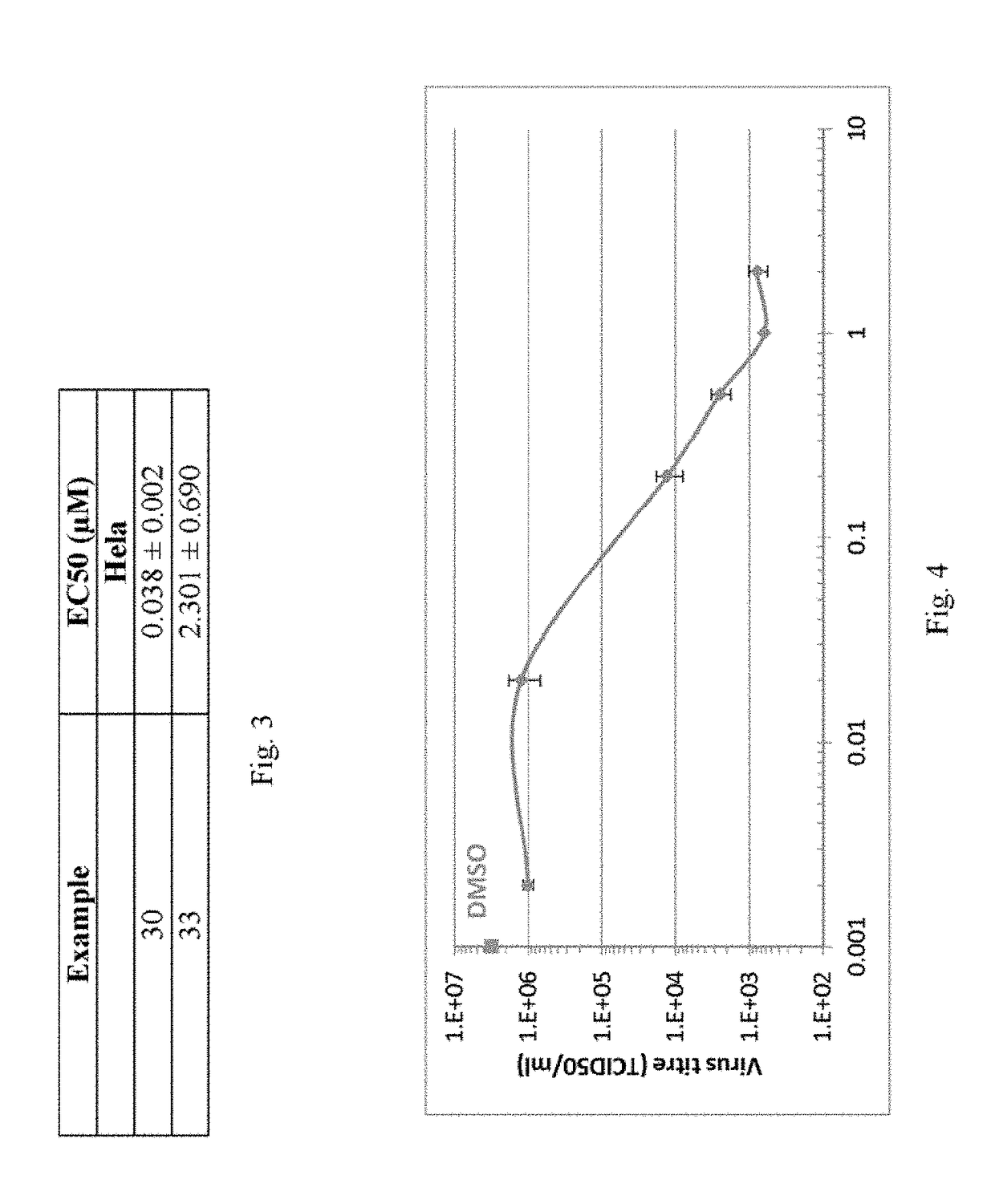Compounds And Their Use As Inhibitors Of N-Myristoyl Transferase
- Summary
- Abstract
- Description
- Claims
- Application Information
AI Technical Summary
Benefits of technology
Problems solved by technology
Method used
Image
Examples
preparation of examples 1-108
Example 1
[0499]
N,N-dimethyl-1-(5-(2-(pyridin-3-ylmethoxy)phenyl)-1H-indazol-3-yl)methanamine
Step 1
[0500]According to the general method for mesyl transfer (Method A), intermediate 1 (43 mg, 0.1 mmol was reacted with 3-pyridinemethanol (9.7 μL, 0.1 mmol) and sodium t-butoxide (9.6 mg, 0.1 mmol) in acetonitrile (0.5 ml). Partial purification by column chromatography provided the THP protected indazole. δH / ppm 1H NMR (400 MHz, Chloroform-d) δ 8.61 (d, J=2.2 Hz, 1H), 8.53 (dd, J=4.9, 1.6 Hz, 1H), 8.01 (d, J=1.5 Hz, 1H), 7.65-7.59 (m, 2H), 7.58 (s, 1H), 7.42 (dd, J=7.5, 1.8 Hz, 1H), 7.32 (td, J=7.9, 1.9 Hz, 1H), 7.23 (dd, J=7.9, 4.8 Hz, 1H), 7.11 (d, J=7.5 Hz, 1H), 7.07 (d, J=8.4 Hz, 1H), 5.71 (dd, J=9.8, 2.6 Hz, 1H), 5.09 (s, 2H), 4.09 (s, 1H), 3.81 (s, 2H), 3.77 (td, J=11.6, 3.1 Hz, 1H), 2.67-2.51 (m, 1H), 2.29 (s, 6H), 2.16 (ddd, J=8.8, 4.5, 2.3 Hz, 1H), 2.11-2.07 (m, 1H), 1.84-1.71 (m, 2H), 1.65 (dt, J=9.3, 3.1 Hz, 1H).
Step 2
[0501]According to the general method for THP deprotection ...
example 31
[0504]
(5-(4-fluoro-2-(2-(1,3,5-trimethyl-1H-pyrazol-4-yl)ethoxy)phenyl)-1-methyl-1H-indazol-3-yl)methanamine
[0505]Intermediate 6 (240 mg; 0.59 mmol) in ethanol (10 mL) was treated with hydroxylamine hydrochloride (74 mg; 1.06 mmol) and sodium acetate (97 mg; 1.18 mmol) and the reaction was stirred for 15 hours at room temperature. Water (50 mL) was added and the resulting solid oxime isolated by filtration (197 mg colourless solid, MH+ 422). mp 230-233° C. The solid (100 mg) in methanol (6 mL) was treated with zinc dust (155 mg, 2.4 mmol) and ammonium formate (150 mg, 2.4 mmol). The suspension was heated under reflux for 4 hours before being cooled to room temperature and filtered through celite. Methanol was removed under reduced pressure and the residue purified by LC-MS by gradient elution with methanol / water / formic acid (50:50:0.1 to 98:2:0.1). Fractions containing the desired product were combined and evaporated under reduced pressure to give the title compound as a colourless ...
example 32
[0506]
1-(5-(5-fluoro-2-(2-(1,3,5-trimethyl-1H-pyrazol-4-yl)ethoxy)phenyl)-1-methyl-1H-indazol-3-yl)methanamine
[0507]Intermediate 9 (50 mg; 0.123 mmol) in ethanol (3 mL) was treated with hydroxylamine hydrochloride (15 mg; 0.22 mmol) and sodium acetate (20 mg; 0.25 mmol) and the reaction was stirred for 15 hours at room temperature. Water (20 mL) was added and the resulting solid oxime isolated by filtration (31 mg colourless solid, MH+ 422). The solid (31 mg) in methanol (2 mL) was treated with zinc dust (48 mg, 0.70 mmol) and ammonium formate (46 mg, 0.70 mmol). The suspension was heated under reflux for 3 hours before being cooled to room temperature and filtered through celite. Methanol was removed under reduced pressure and the residue purified by LC-MS by gradient elution with methanol / water / formic acid (50:50:0.1 to 98:2:0.1). Fractions containing the desired product were combined and evaporated under reduced pressure to give the title compound as a colourless solid formate sa...
PUM
 Login to View More
Login to View More Abstract
Description
Claims
Application Information
 Login to View More
Login to View More - R&D
- Intellectual Property
- Life Sciences
- Materials
- Tech Scout
- Unparalleled Data Quality
- Higher Quality Content
- 60% Fewer Hallucinations
Browse by: Latest US Patents, China's latest patents, Technical Efficacy Thesaurus, Application Domain, Technology Topic, Popular Technical Reports.
© 2025 PatSnap. All rights reserved.Legal|Privacy policy|Modern Slavery Act Transparency Statement|Sitemap|About US| Contact US: help@patsnap.com



